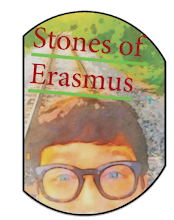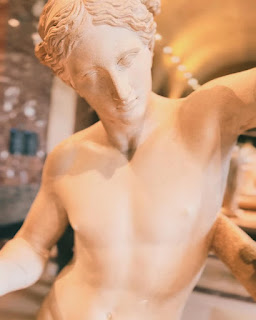Hi, I’m Greig — welcome! Here you’ll find sharp writing, creative ideas, and standout resources for teaching, thinking, making, and dreaming in the middle and high school ELA and Humanities classroom (Grades 6–12).
29.4.24
Fostering Textual Ownership: Passionate Teacher Explores Literacies & Strategies. Periodt. 📚
 I am an educator and a writer. I was born in Louisiana and I now live in the Big Apple. My heart beats to the rhythm of "Ain't No Place to Pee on Mardi Gras Day". My style is of the hot sauce variety. I love philosophy sprinkles and a hot cup of café au lait.
I am an educator and a writer. I was born in Louisiana and I now live in the Big Apple. My heart beats to the rhythm of "Ain't No Place to Pee on Mardi Gras Day". My style is of the hot sauce variety. I love philosophy sprinkles and a hot cup of café au lait.
4.4.24
Zeus Ammon at the Met: A Greek-Egyptian Syncretism in Stone
 I am an educator and a writer. I was born in Louisiana and I now live in the Big Apple. My heart beats to the rhythm of "Ain't No Place to Pee on Mardi Gras Day". My style is of the hot sauce variety. I love philosophy sprinkles and a hot cup of café au lait.
I am an educator and a writer. I was born in Louisiana and I now live in the Big Apple. My heart beats to the rhythm of "Ain't No Place to Pee on Mardi Gras Day". My style is of the hot sauce variety. I love philosophy sprinkles and a hot cup of café au lait.
3.4.24
Exploring Cuneiform Tablets at the NYPL: The Ancient Roots of Homework
 I am an educator and a writer. I was born in Louisiana and I now live in the Big Apple. My heart beats to the rhythm of "Ain't No Place to Pee on Mardi Gras Day". My style is of the hot sauce variety. I love philosophy sprinkles and a hot cup of café au lait.
I am an educator and a writer. I was born in Louisiana and I now live in the Big Apple. My heart beats to the rhythm of "Ain't No Place to Pee on Mardi Gras Day". My style is of the hot sauce variety. I love philosophy sprinkles and a hot cup of café au lait.
31.3.24
Alexander the Great's Portrait at British Museum: Deification & Legacy in Art
 I am an educator and a writer. I was born in Louisiana and I now live in the Big Apple. My heart beats to the rhythm of "Ain't No Place to Pee on Mardi Gras Day". My style is of the hot sauce variety. I love philosophy sprinkles and a hot cup of café au lait.
I am an educator and a writer. I was born in Louisiana and I now live in the Big Apple. My heart beats to the rhythm of "Ain't No Place to Pee on Mardi Gras Day". My style is of the hot sauce variety. I love philosophy sprinkles and a hot cup of café au lait.
27.3.24
Overcoming Bullying: A Personal Journey of Strength and Advocacy.
 I am an educator and a writer. I was born in Louisiana and I now live in the Big Apple. My heart beats to the rhythm of "Ain't No Place to Pee on Mardi Gras Day". My style is of the hot sauce variety. I love philosophy sprinkles and a hot cup of café au lait.
I am an educator and a writer. I was born in Louisiana and I now live in the Big Apple. My heart beats to the rhythm of "Ain't No Place to Pee on Mardi Gras Day". My style is of the hot sauce variety. I love philosophy sprinkles and a hot cup of café au lait.
26.3.24
Portfolio: Mr. Roselli's Teaching Career in a Visually Appealing Presentation
Teaching Statement
Everything I do revolves around Arts and Letters. As a kid, I haunted my local public library and connected with teachers and coaches. As an adult, I’ve worked with learners aged ten to eighteen and thrive when students share stories, thoughts, writing, drawings, and future ambitions.
I teach ethical thinking within Humanities and ELA, adapting instruction to engage each class and collaborating with colleagues when units align. Instruction evolves to meet students’ needs, hooking and sustaining their curiosity through co-planning and shared resources.
I design learning spaces with maps, anchor charts, and reading materials that spark inquiry. I love when students exclaim, “Mr. Roselli—look what I read!” because they see me as a fellow learner in our shared journey.
Active Teacher: Celebrating Diversity, Values, Clubs & Student Groups
I engage in school life by celebrating our community’s diversity, upholding traditions, facilitating after-school clubs, and helping students find affinity groups. My commitment extends beyond the classroom into every corner of school culture.
Collaboration in the High School English Language Arts Classroom
Bringing Octavia Butler’s Kindred to life, my eleventh graders dramatized profiles of social justice, historical resistance, and time travel between modern Los Angeles and antebellum Maryland.
Writing Strategies
Independent Reading Initiatives
Are you tired of Netflix? Every summer, I spearhead a themed reading initiative featuring voices like Ibram X. Kendi and Jason Reynolds. During the year, students select books, read in class, and share reviews to foster lifelong reading habits.
Field Trips
Community Involvement
 I am an educator and a writer. I was born in Louisiana and I now live in the Big Apple. My heart beats to the rhythm of "Ain't No Place to Pee on Mardi Gras Day". My style is of the hot sauce variety. I love philosophy sprinkles and a hot cup of café au lait.
I am an educator and a writer. I was born in Louisiana and I now live in the Big Apple. My heart beats to the rhythm of "Ain't No Place to Pee on Mardi Gras Day". My style is of the hot sauce variety. I love philosophy sprinkles and a hot cup of café au lait.
20.3.24
Sully Wing Secrets: Louvre's Greek and Egyptian Wonders
Discover a teacher's unique Louvre encounters, from Greek beauty to Egyptian relics. Explore beyond Mona Lisa to uncover the Louvre's heart.
 |
| (2) Apollon Sauroctone |
 |
| (1) Éphèbe |
![Un fleuve Barye, Antoine Louis. Un fleuve. 19th century, France. Musée du Louvre, Department of Sculptures of the Middle Ages, Renaissance, and Modern Times, inventory number RF 1560 & RF 1561. Louvre Museum, Sully, [HIST LOUVRE] Salle 134 - Salle de la maquette, Vitrine 08](https://blogger.googleusercontent.com/img/b/R29vZ2xl/AVvXsEhRE9YnlXlK6KfP-A0z_dJZYnBT7_1M5T9D3tZk_gXozKs9gMd9nO9UXlkT5TkHi9T0KkSBwjL6qcfr74jTaMOtO6h47D1jJt4P6LadIo9MGzu3yL8o9KabJ2TLnGC05aMOJLGXy08A5kn4PeMuqb1xi3BchLe5z6tW_ddtYaAY0Te_gBcwPo7btQ/w180-h320/A65BC7E3-435F-4BF6-9AEE-992B60DCA921.jpg) |
| (3) Un fleuve |
![Statue of a Sphinx Musée du Louvre. Statue of a Sphinx. Circa 380-362 B.C. [?], Serapeum of Memphis, Saqqara. Musée du Louvre, Department of Egyptian Antiquities, Room 327, Sully, inventory number N 391 D. Louvre Museum](https://blogger.googleusercontent.com/img/b/R29vZ2xl/AVvXsEjgUwtk13qrP7vP1aawA_H8HLkuH_Om2fdXDUYZS5rp9gzDUj93w2JqthNzZp3HNWS8AsQqXaXeJC5UwcvtUI0RDp8NLgjTSiUTlm3d7iOqPGBZHf7o5BGbsuMqcyb0dXuT7bz1agggYfGBhFF45As03mepTGdzalqV6E6H9gy3r1oIJpCqEAcp_A/w256-h320/2B604D01-4603-465D-9A7E-BE621258F15E.jpg) |
| (4) Statue of a Sphinx |
![Statue Musée du Louvre. Statue. Third Intermediate Period, circa 1069-664 B.C. [?]. Musée du Louvre, Department of Egyptian Antiquities, inventory numbers E 2410; N 1579; Clot bey C 25 no. 5. Louvre Museum](https://blogger.googleusercontent.com/img/b/R29vZ2xl/AVvXsEjgbctrJI65LJI1iyrVOfQhyphenhyphene1Tc7QGTT4wcBmC08D_-9ItrigFHgGkqlDv2rPXfIA1CmP6V8ZIqsfUQ7CGr0K2fEwD4wjU7gBYdxKLbgTQEFFjb50Ge3hY9aGWehNd6EDdhxp35uN-0HYHIBL-vXWIXJD-NcecFiFCi6zVnQWKKJnMVmExZpZKfQ/w256-h320/75DFE6FB-8092-4AAD-8E84-5475A684CEDD.jpg) |
| (5) Statue |
![Jupiter Musée du Louvre. Jupiter. 2nd century A.D. [?], Italy. Musée du Louvre, Department of Greek, Etruscan, and Roman Antiquities, Room 344.](https://blogger.googleusercontent.com/img/b/R29vZ2xl/AVvXsEh9FIeOZBWXHqm5AryH2Cb0EdwkG_C2QX7rHPa3IQTeF_q7JBsmrEfeSbekVmJaSLsg_k0Zb9dCdUctsB_i8rQA2dVqXkSQoBwP9IxfPLOA-5B4ufz0bVSvIVbKjqkpQeJ2U2Gl6C53r3ylcqsay29L5YfAPJNU4zaHvj3boIWM6pv3BF-rpLhZqA/w256-h320/72D6CC7E-0683-4B1E-AA7E-FA3A9611BA85.jpg) |
| (6) Jupiter |
 I am an educator and a writer. I was born in Louisiana and I now live in the Big Apple. My heart beats to the rhythm of "Ain't No Place to Pee on Mardi Gras Day". My style is of the hot sauce variety. I love philosophy sprinkles and a hot cup of café au lait.
I am an educator and a writer. I was born in Louisiana and I now live in the Big Apple. My heart beats to the rhythm of "Ain't No Place to Pee on Mardi Gras Day". My style is of the hot sauce variety. I love philosophy sprinkles and a hot cup of café au lait.







.png)
.png)
.png)